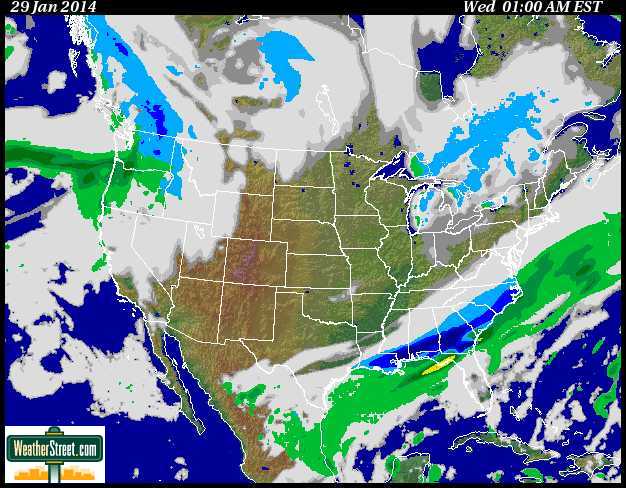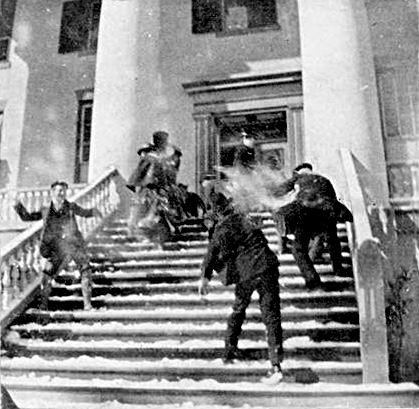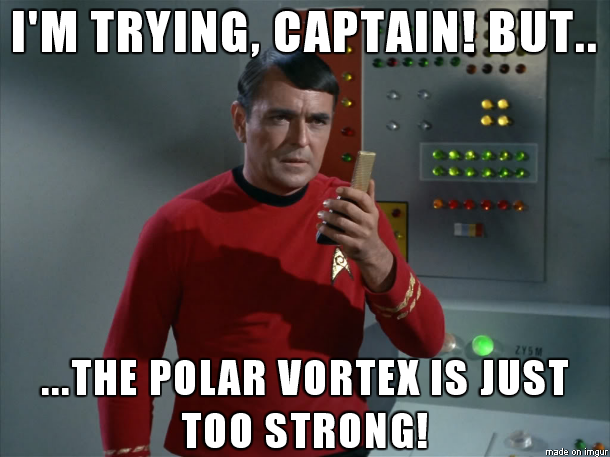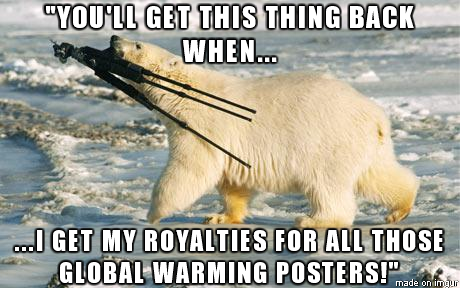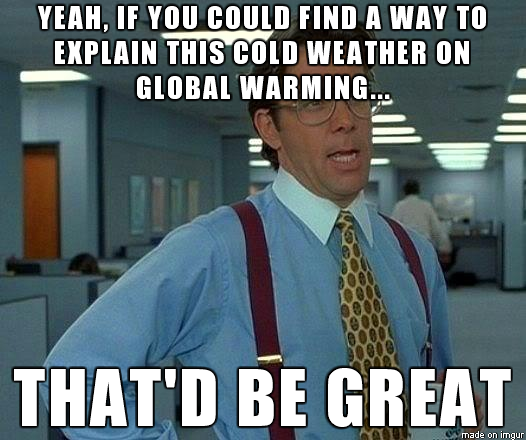Here’s the latest 48 hr total snowfall forecast (from the NAM model) ending Wednesday morning (it assumes all frozen precip. falls as snow…where it’s freezing rain or sleet, the depths will be less):
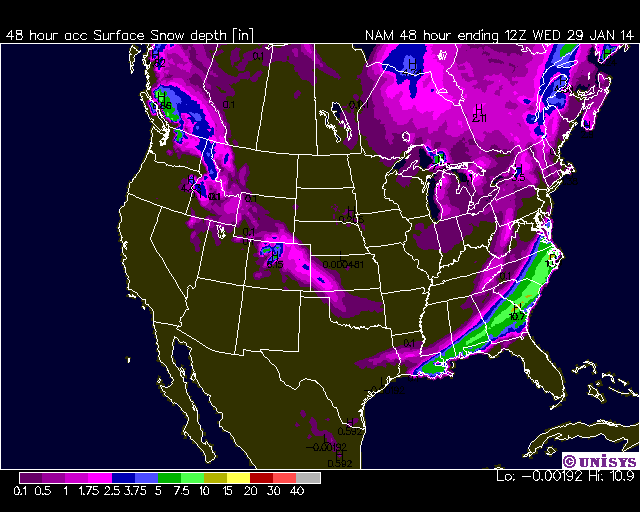
See our WeatherStreet.com snowstorm forecast page for additional forecast products.
Archive for January, 2014
SE U.S. Snowstorm Update
Monday, January 27th, 2014Climate Change’s Inherent Uncertainties
Sunday, January 26th, 2014I don’t usually recommend articles on other blogs.
But there is an unusually good essay at Quadrant Online about the pickle climate scientists now find themselves in after selling their souls to their government masters in order to produce “scientific evidence” of human-caused climate change.
In Climate Change’s Inherent Uncertainties, Garth Paltridge also lays out in simple terms why climate forecasts can’t be trusted.
I couldn’t find a single statement that I disagreed with. Which is strange, because I disagree with myself on a routine basis.
SOTU, 2014: Obama will use wintry weather as example of global warming
Sunday, January 26th, 2014
I predict that, despite the brutally cold weather in DC this Tuesday, Obama will preach on climate change in his State of the Union address. I predict he will even use the cold weather as evidence to support his case.
During his address it looks like there will be a wintry mix starting across the southern reaches of Louisiana, Mississippi, Alabama, Georgia, the Carolinas, and the Florida panhandle. I wouldn’t be surprised if he uses the event as evidence of human-caused climate change.
For those of us old enough to remember, similar events happened back in the epic cold winters of the 1970s. Many instances of snow falling in Florida in the 1800s surely weren’t due to humans. Believe it or not, more snow tends to go with colder weather, not warmer. Go figure.
Has everyone forgotten that the global warming prophets predicted winters without snow?
And there is no credible evidence that climate change (induced by global warming) can produce colder than normal temperatures. There has been no long-term change in mid-latitude storminess. One climate model out of a hundred might produce colder weather over less than 1% of the Earth with global warming….those are damn long odds to hang your hat on.
But you know that if this winter was 20 deg. above normal rather than below normal, that would be used as evidence of global warming. Some people want to have it both ways. That sounds to me more like political spin than science.
Still, I’m sure the President can find a few scientists who will support him. So he’s covered.
Yes, we live in interesting times.
U.S. temperatures, 1973-2013: A alternative view
Friday, January 24th, 2014Steve Goddard recently posted some results from his analysis of the official U.S. surface temperatures (USHCN, from NOAA) suggesting spurious warming occurring around 1998. I also showed evidence of this back in 2012.
Steve’s post reminded me that it’s been over a year since I’ve updated the U.S.-average Integrated Surface Hourly (ISH) temperature data, using my Population Density Adjusted Temperature (PDAT) algorithm that corrects for changing urban heat island (UHI) effects. This is still an unpublished method, and so should be considered more of a sanity check on the official NOAA USHCN product. But it does support Steve’s contention that there’s something funny going on in the USHCN data.
One of the big differences between my ISH PDAT dataset and the official NOAA products is that mine is based upon about 270 stations which monitor hourly temperatures, from which I compute a daily average temperature from the observations at 00, 06, 12, and 18 UTC. This avoids time-of-observation problems associated with computing daily averages from maximum and minimum temperatures, as is done in the USHCN dataset.
Secondly, my dataset only starts in 1973 because that’s the first year with reasonably complete coverage of the U.S. with the hourly observation sites (not the cooperative observer sites which dominate the USHCN dataset which are more numerous but report daily max and min temperatures).
Thirdly, my adjustment for UHI effects is more straightforward than the NOAA homogenization procedure, which I consider rather “opaque”. I believe the NOAA methodology is prone to warming rural sites to match urban sites, rather than cooling the urban sites to match the rural sites. I can’t prove this because, as I said, the homogenization methodology is, well, opaque. In the U.S., my population density adjustment ends up subtracting off an average of about 0.1 deg. C/decade from the temperature trends, but that varies for each station depending upon the change in population density over time. A good place to start for a description of the population density adjustment to temperatures is here. (I now use a constant population density vs. temperature curve for all areas except the Pacific Northwest and the southwest U.S., which show no obvious average warming effects with population density.)
The yearly temperature anomalies for 1973-2013 show that, for the contiguous 48 states, the USHCN Tmax+Tmin observations indicate considerably more warming than the 4x/day temperature observations adjusted for local population density changes (dashed curve fits are 2nd order polynomials):
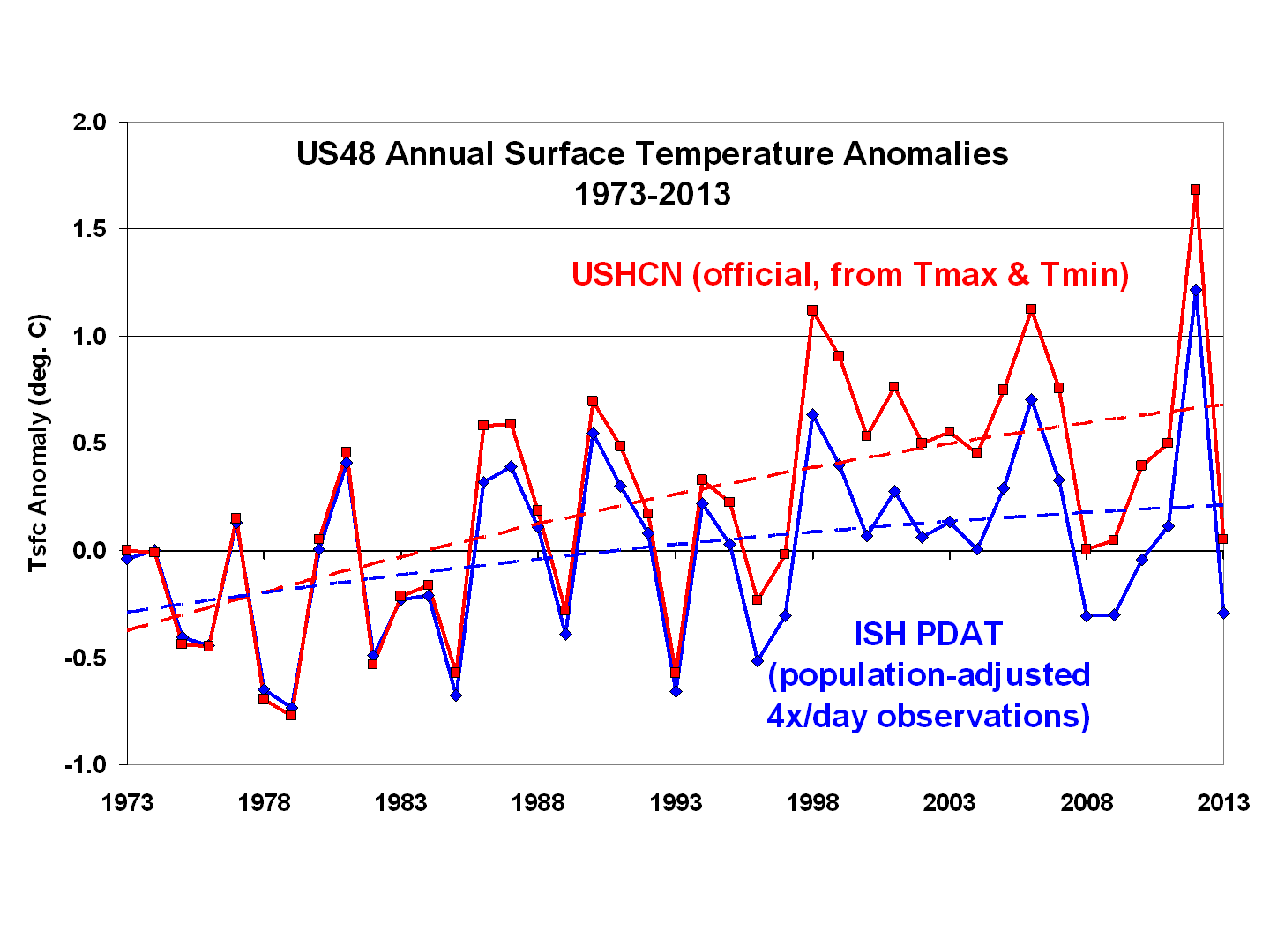
A difference plot of the 2 datasets, as I showed almost 2 years ago, reveals the biggest discrepancy occurs around 1998:
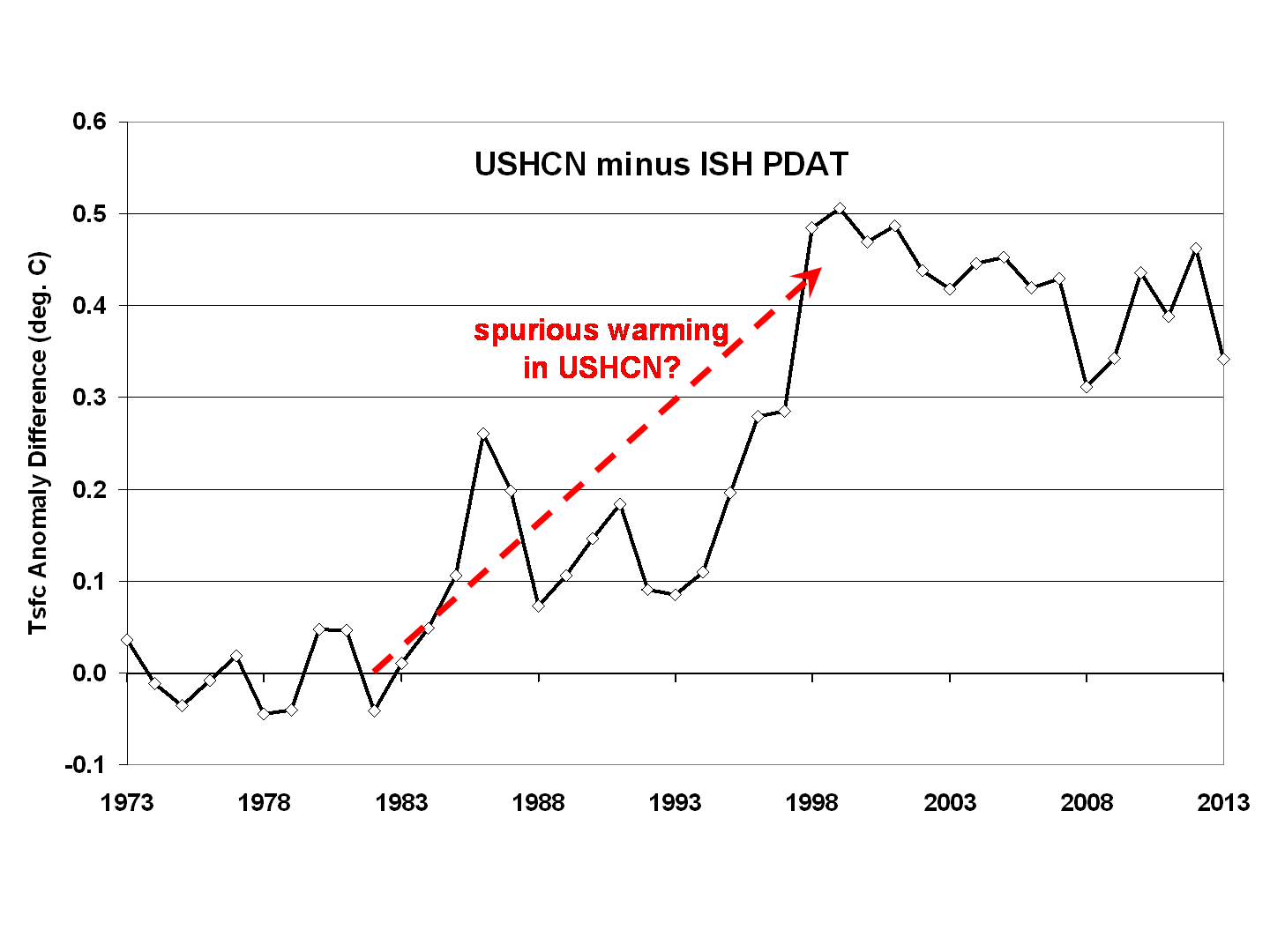
I don’t know all of the sources of these discrepancies, which partly remain even if I *don’t* do a population density adjustment to my dataset:
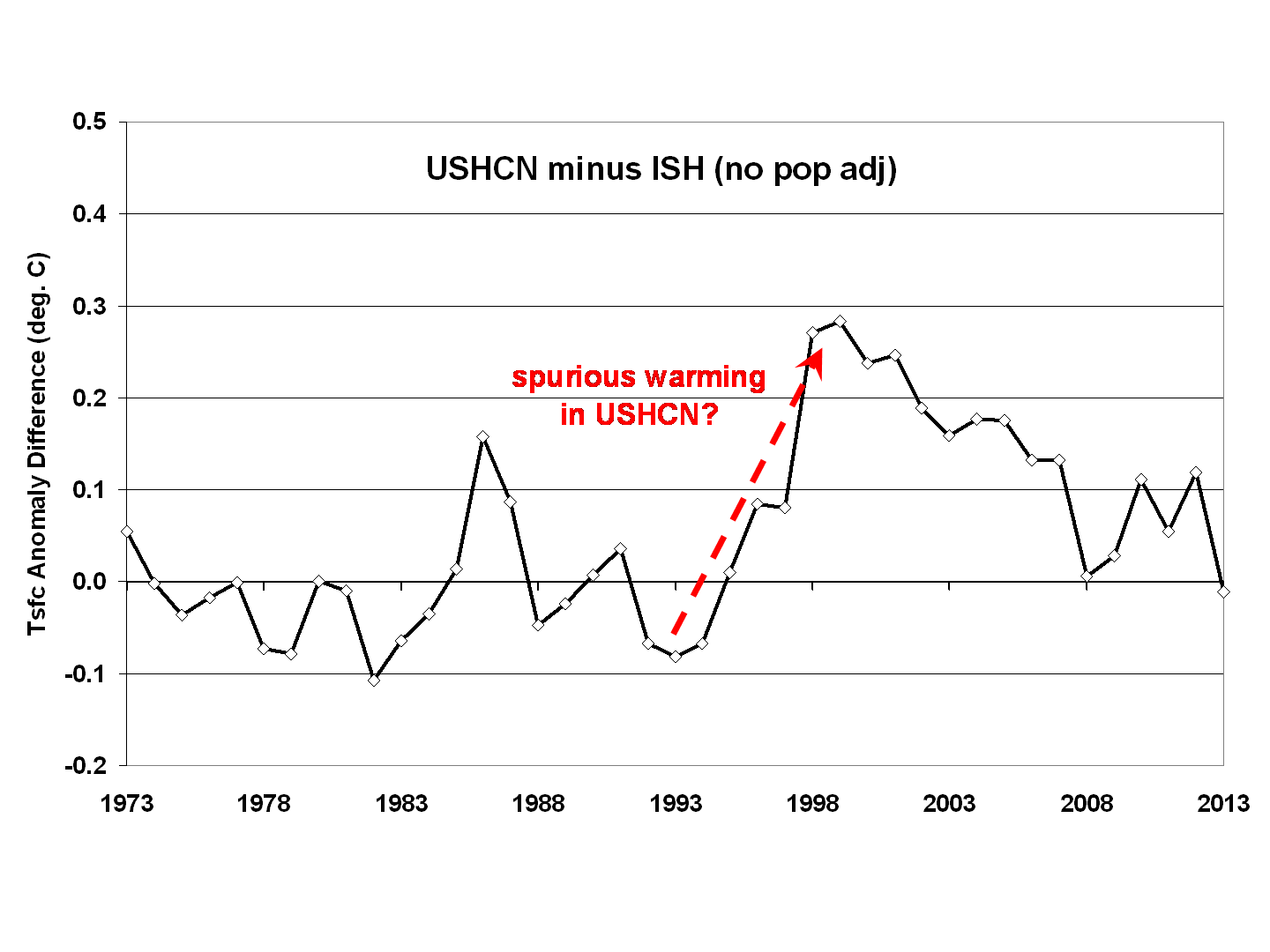
At some point I need to update the population density adjustment, which originally relied on only 1990 and 2000 census data, which I extrapolated forward and backward in time. Now that NASA/SEDAC has population density estimates up to the present, this would provide some improvement to the adjustments for urban heat island effects.
Clearly, adjustments to surface temperature data are at least as large as the global warming signal being sought. Until a transparent analysis of the USHCN methodology is carried out, and alternative methods and temperature datasets are tested, I can’t bring myself to believe any U.S. government pronouncements regarding record warm temperatures.
ADDENDUM
I see that my previous posts don’t really provide the info needed for those interested in how I’m doing the temperature trend adjustments from changes in population density over time. Here’s the regression relationship I am using:
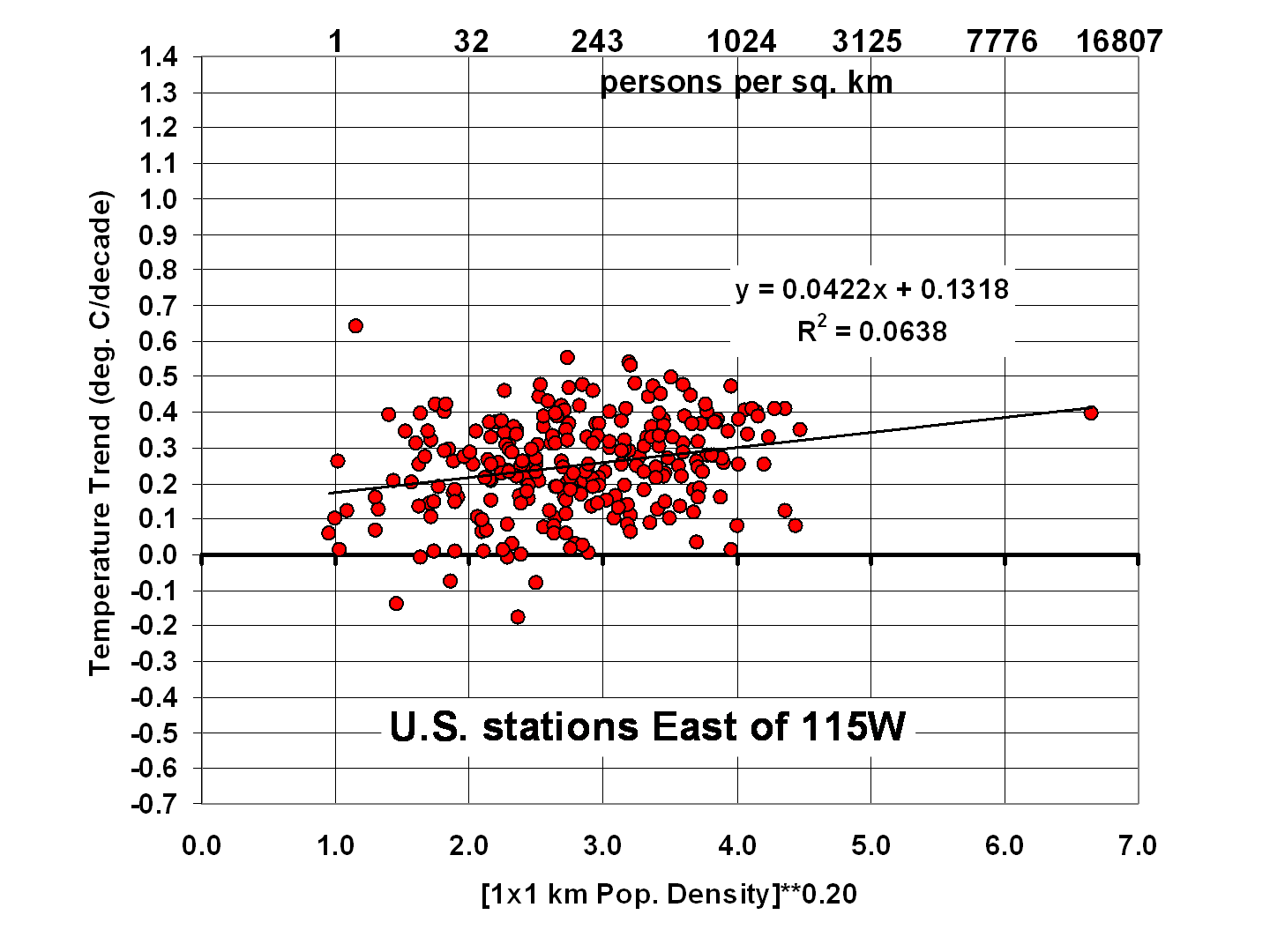
For each station east of 115W, I adjust its temperature anomaly time series using the 0.0422 regression coefficient applied to the change in station location population density (to the 0.2 power) between 1990 and 2000 (extrapolated back to 1973, and forward to 2013). The adjustment starts at zero in 1973, then decreases the trend linearly with time if the population went up, or decreases increases the trend with time if the population went down. The 0.2 power factor is consistent with previous studies that showed the strongest UHI effects occur early in population growth, then level off at higher population densities.
Al Gore’s 10-year warning – only 2 years left, still no warming
Friday, January 10th, 2014It’s been 8 years since Al Gore told us in January 2006 that we had only 10 years left to solve the global warming problem.
In the grand tradition of prophets of doom, his prognostication is not shaping up too well…still no statistically significant warming:
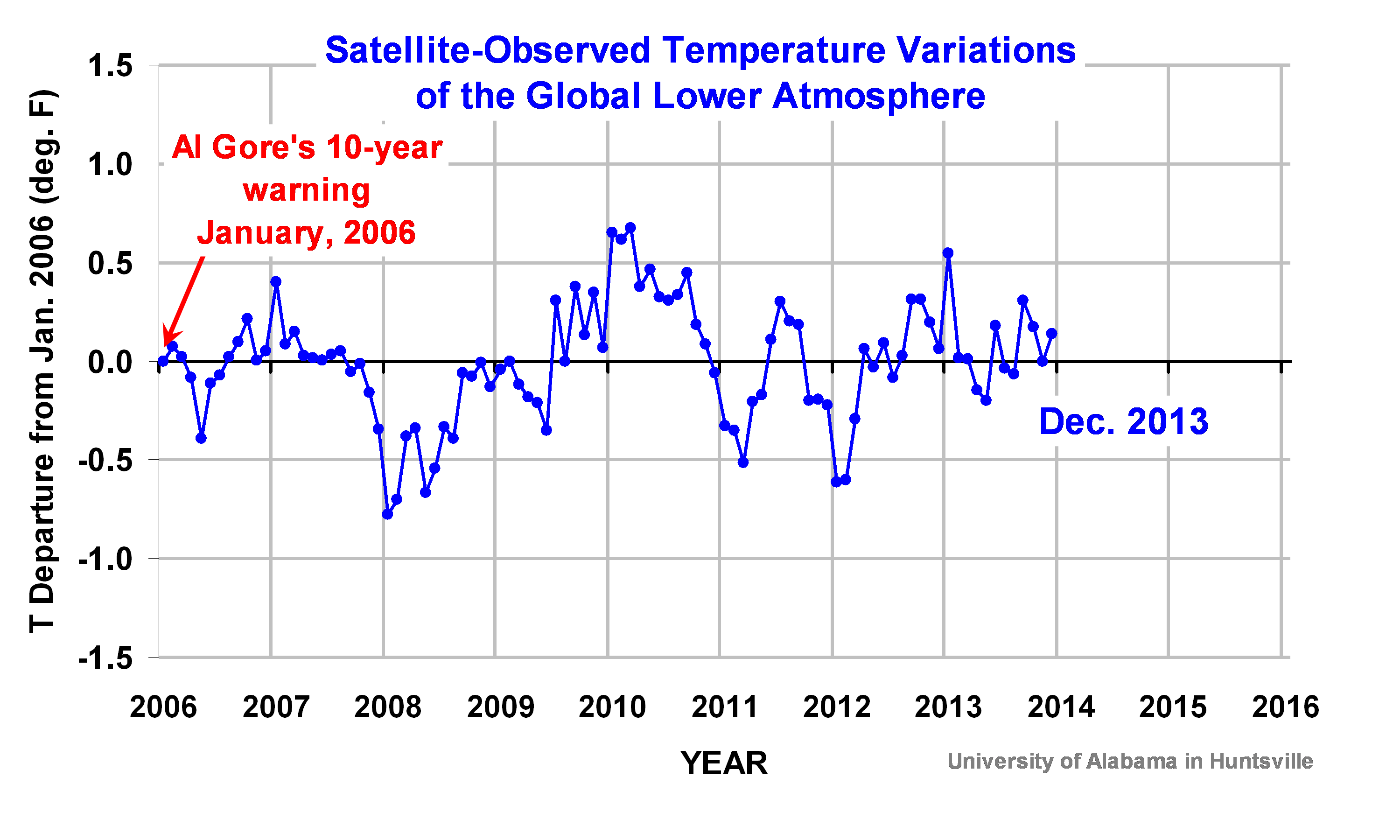
And if you use RSS version of the satellite data, it will look even worse for Mr. Gore.
Oh, I know. All that extra energy, hundredths of a degree of it, could be hiding in the deep ocean. Good luck getting Mr. and Mrs. Taxpayer worked up over that one.
John Holdren, Pseudoscience Czar, predicted waste heat would doom humanity
Friday, January 10th, 2014I have to admit to being a little embarrassed for John Holdren, President Obama’s Science Czar. How did this man ever attain such a lofty position, other than his politics?
A couple of days ago, Holdren went on the record claiming the recent cold weather was due to global warming. Published research has found no evidence to back up such a claim…there has been no long-term change in the baroclinic wave pattern. Besides, how does a reduced equator-to-pole temperature gradient lead to more baroclinic wave activity?
But this part of Holdren’s history takes the cake. As described at zombietime.com, Holdren co-authored a book chapter with Paul Ehrlich (the honorary Failed Forecast Czar) back in 1971 entitled Overpopulation and the Potential for Ecocide. In that chapter, they forecast both a human-caused ice age and human-caused warming, with the latter being the biggest threat.
What is astounding from a science perspective is that Holdren blamed warming on waste heat, the result of humans and their energy use, rather than a slowly increasing greenhouse effect. He predicted that the localized nature of this waste heat would eventually spread to be a global problem.
But a little research and few minutes of math (which I assume Holdren learned at some point) would have revealed that humanity’s waste heat generation is, from a global perspective, trivial.
Assuming today’s global energy use is about 150 petawatthours per year, and dividing that by the number of hours in a year and the surface area of the Earth, this yields an average energy flux of 0.03 Watt per sq. meter. This is about 100 times smaller than the estimated heating from increased carbon dioxide in the atmosphere. It is almost 10,000 times smaller than the rate of solar energy input into the Earth.
It scares me that someone with so much energy policy influence has so little knowledge of basic physics.
Global warming meme collection for this week
Thursday, January 9th, 2014Science and religion: Do your own damn Google search
Tuesday, January 7th, 2014Why is it that a bible-believing scientist’s views on science are automatically discounted by some people?
I usually try to avoid the “R” issue, except that Ethan Epstein of the Weekly Standard chose to take a swipe at me in his otherwise good article on our dean of climate skeptics, Dick Lindzen.
Normally, I just ignore this stuff, but my e-mail has been blowing up in the last couple of days. So, against my better judgment, here are some thoughts on the subject…more for the benefit of those who are more outraged than I am (I expect to be attacked).
First, the hypocrisy. When warmist scientists like Sir John Houghton use the Bible to support action to fight global warming (e.g. his book Global Warming: The Complete Briefing) that was OK with everyone. Same with Katherine Hayhoe and Thomas Ackerman.
So, I guess it depends upon whether the bible-believer agrees with them before the warmists decide to trash Bible-believing ways.
In the case of global warming skeptics, I suppose the accusation is part of the assumption that bible-believers feel that “God is in control”, and so everything will turn out OK no matter what we do. Go ahead and pump all the CO2 into the atmosphere you want. The Big Guy will take care of it.
Except that I don’t put myself in this class. I readily admit that we have more than enough nuclear weapons to virtually wipe out humanity. I admit that evidence of human pollution can be found in almost every corner of the world.
In other words, we know that humans are capable of creating a huge amount of misery for ourselves, which we have done repeatedly down through history. Catastrophic global warming could, at least theoretically, be just one more example of this.
Except that I view CO2 as one of those cases where nature, on a whole, benefits from more of our “pollution”. The scientific evidence is increasingly supporting this position.
This is not a big stretch considering that CO2 is necessary for life to exist on Earth, and yet only 4 molecules out of every 10,000 in the atmosphere are CO2. Venus and Mars have atmospheres that are almost 100% CO2; life on Earth, in contrast, has sucked most of it out of the atmosphere. No matter how much we produce, nature automatically takes out 50% and uses it.
Epstein incorrectly assumes that I support the wording of all of the positions of the Cornwall Alliance, as stated in their Cornwall Declaration. But the Director of the Cornwall Alliance knows I don’t. We’ve discussed it.
Nevertheless, I still support the work of Cornwall. Seldom does a member of an organization agree with all of that organization’s stated positions.
Why do I support it? The central reason is I believe that current green energy policies are killing poor people.
Anything that reduces prosperity kills the poor. This is the single biggest reason I speak out on global warming, and why the Cornwall Alliance speaks out against policies which end up hurting the poor much more than they help.
Radical environmentalism is interested in seeing more people dead than alive. I don’t care what their press releases say. I’ve debated enough of these folks to know that their biggest complaint is that there are too many people in the world.
Some have claimed that the Earth would be just lovely without any humans. (Extra points for anyone who can spot the oxymoron there).
On a more superficial level, the accusation is often that the Bible-believing scientist “rejects settled science”, in my case the naturalistic “explanation” for the origin of life. How can anyone trust a climate scientist who rejects “settled science”?
Except this claim reveals an appalling lack of knowledge on the part of the accuser. In general, nothing in science is ever settled. And in particular, no one knows how life arose from non-living matter. It remains a mystery today.
Belief in the naturalistic origin of life is just as religious as the belief in a creator. Even well-known evolutionists have admitted this.
The scientific evidence for a “creator” is, in my opinion, stronger than the evidence that everything around us is just one gigantic cosmic accident. I have no trouble stating that — and defending it — based upon science alone. No need to quote the Bible.
But why should any of this matter for real, observable science, like climate change? Belief in macroevolution is a religion, not science. It is an organizing system of thought, a conceptual model of origins, a worldview, which the evolutionist must fit all of his observations into.
The only explanation I can think of for the Weekly Standard swipe at me is that Mr. Epstein is one of the great sea of journalists who has a considerable breadth of knowledge of many subjects, but only limited depth.
Epstein is probably not aware that science is based upon a set of assumptions — unprovable assumptions. That nature is real. That humans are capable of knowing its true nature. That nature is unified.
The existence of the universe itself violates either the 1st or 2nd Laws of Thermodynamics. That’s why cosmologists must invent physics no one has ever observed to explain how everything came to be.
Is that “science”? Really?
Epstein doesn’t understand that even atheist scientists are also guided by their religious belief that there is no creator. All scientists interpret data based upon their preconceived notions.
In Earth science, I find most researchers believe nature is fragile. But that is not a scientific position, it is a religious one. No less religious than my view that nature is resilient.
In short, there is no such thing as an unbiased scientist.
Furthermore, apart from religious considerations, not all scientific problems are created equal. Surely even journalists are capable of understanding that.
For example, the force of gravity is relatively simple, and we can predict the position of the planets far in advance with great accuracy because gravitation is just about the only force that needs to be considered in those calculations.
But the complexity of the climate system, and especially how it varies, is orders of magnitude more difficult to understand. It currently exceeds our ability to usefully predict its future state. Who can look at the epic failure of the climate models to explain past (let alone future) tropical temperatures over the last 30+ years, and still think that scientists can foretell climate?
And if scientists ever are able to “create life” in a test tube from non living chemicals, through all of their hard work and creativity, exactly what will that have proved?
That life could have arisen by chance? Really? Think about it.
Furthermore, life has to do more than just come into being. It has to reproduce. How does that happen by chance? Researchers have computed the probability of it happening to be essentially zero.
I’m afraid my faith isn’t strong enough to believe in such silliness.
And if you are going to comment, “Exactly what research shows all of this, Dr. Spencer?” Well, to paraphrase (and with apologies to) William F. Buckley, Jr., “Do your own damn Google search.”
Does Global Warming Theory Predict Record Cold?
Monday, January 6th, 2014NO.
Comments on the recent “warming is worse than we thought” Nature paper
Monday, January 6th, 2014This is the first paper in a long time that made my brain hurt to read.
“Spread in Model Climate Sensitivity Traced to Atmospheric Convective Mixing“, by Sherwood, Bony, and Dufresne is actually quite well written (Nature editors help to make sure scientists don’t publish bad prose in their magazine). But the concepts involved are pretty complicated, which is what happens when you try to understand atmospheric convection.
Basically, the authors claim to show that a significant amount of the spread in the climate sensitivity across dozens of climate models is due to how the models partition tropical convection between deep versus shallow convective mixing.
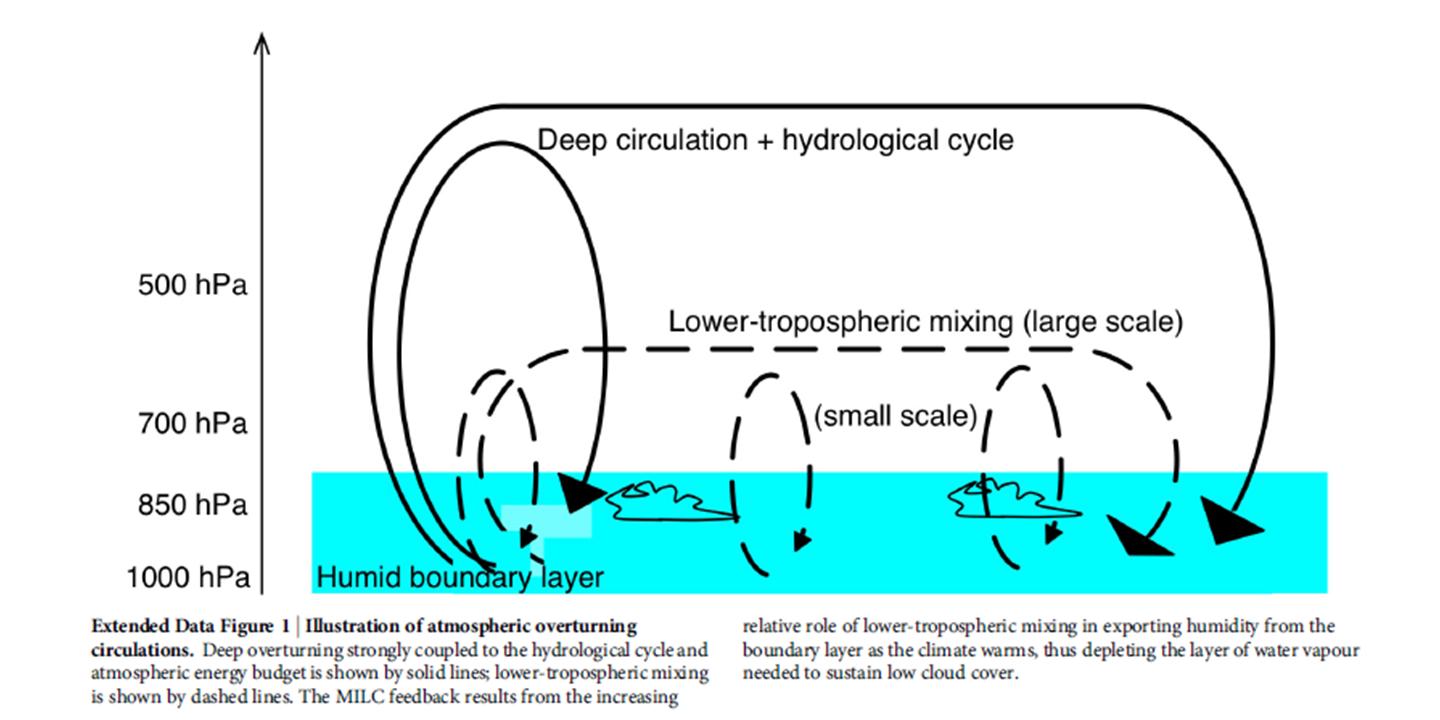
Although I don’t yet fully understand their reasoning, they claim these differences impact low cloud amounts, and thus low cloud feedback in the models. Low cloud feedback is arguably the least certain feedback in models, capable of either greatly amplifying or reducing the small direct warming from more CO2 in the atmosphere.
The authors present evidence that those models which have the strongest shallow mixing are the closest to the observations. Furthermore, since those models also exhibit the strongest positive low cloud feedback, we should believe the predictions of the models that predict the most warming for the future.
(What’s that you say? You thought the models with the most warming were also the ones which have failed most miserably in their temperature predictions over the last 30+ years? Ha! You silly mortal! The Climate Modelers now have a new, complex diagnostic quantity to test models with…not that silly old temperature metric.)
The paper does seem to provide some new and important insight into why different climate models have different strengths of low cloud feedback. But I suspect their “observational evidence” of just how strong shallow mixing in the real tropical atmosphere is (the MERRA reanalysis model) is, in this case, more model than it is observation. We don’t really have direct observations of the average strength of tropical lower tropospheric mixing. And even if it is true that the most sensitive models have the most realistic lower tropospheric mixing, there are so many different compensating (and highly parameterized!) processes in models, I don’t think we can use such model diagnostics as reliable tests for climate sensitivity. At least not yet.
So, for the time being, I’m sticking with the simpler tests…such as simple energy conservation and just how much the ocean/atmosphere system has warmed in the last 50 years.
The paper thus represents a bold prediction in the face of contrary evidence. So I give Sherwood et al. 5 stars out of 5 in the much-coveted cojones category.

 Home/Blog
Home/Blog